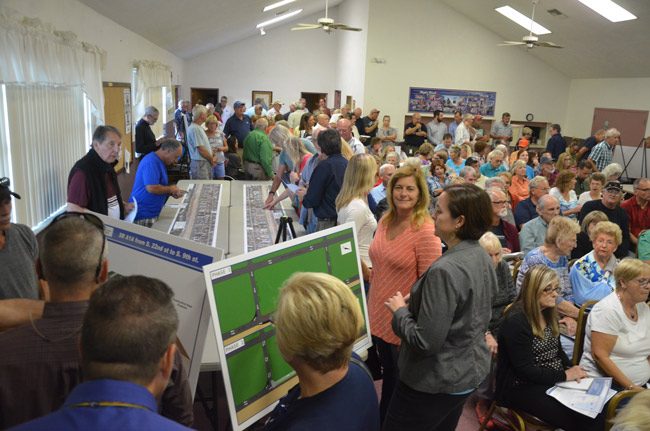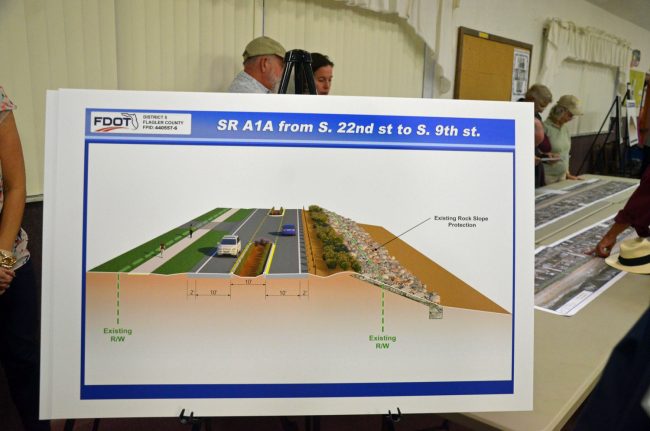
The reconstruction of that stretch of A1A that washed off during Hurricane Matthew at the south end of Flagler Beach will begin next summer. The $5.9 million project covering 1.4 miles, from South 9th to South 22nd streets, will take at least a year, probably a few months more. There will be closures of small segments of the road, about a block to two blocks each, for four to six weeks at a time, with traffic being diverted to avenues west of A1A. No extra right-of-way will be needed.
When the job is done, A1A will be a two-lane road again but with slightly wider lanes than the emergency version currently running along that stretch: each lane will be 10 feet wide. There will also be a 10-foot, grassy median along much of the stretch, with openings at each cross-street and a few more openings between streets to accommodate some, but not all, businesses. The speed limit will be 30 mph.
There will be no parking allowed on the oceanside of A1A, as is the case now with the emergency repair version of the road in place. Rather, there will be a two-foot shoulderrising into a low dune covered with vegetation that then slopes down into the revetment rock currently in place. That rock will not move. There will be no additional rock. That’s here to stay as the permanent protection of the road. It’s also the same kind of rock revetment that may wash out to sea during the next serious storm, putting the road at risk of demolition again.
In that sense, the permanent reconstruction of State Road A1A will be a foundationally no different than its predecessor. The cosmetic, traffic-calming changes above have nothing to do with the essentially unchanged base and structure and protection of the road. That almost certainly means that the permanence of the road is more of a hope, and a slight one at that, than anything like a certainty, given recent history of recurring washouts and a discernible sea rise along the Florida coast, which is only intensifying erosion.
“If you take a direct hit protection of the road is going to be tough,” says Steve Olsen, chief spokesman for the state transportation department, which presented some details of the coming phase of construction to Flagler Beach residents at a standing-room-only hearing Thursday evening at the Methodist church on South Daytona Avenue. “The best we can do is try to mitigate it the best we can.” (Below, you can watch the full presentation the transportation department showed at Thursday’s public hearing. You can keep up with the DOT’s documentation of the project here.)

There will be no sea wall along that stretch of reconstruction, as there will be when segments of A1A are rebuilt further north at a later date.
“We saw this plan and out of all that we saw at the commission we felt that this was the best,” Commissioner Joy McGrew said. “Is it perfect? No. Is it going to be painful? Yes. So put on your seat belts. If you want a road it’s going to hurt to live on Central and Daytona and Flagler and put up with the traffic.” She is hoping for more enforcement to keep speeding down. “I didn’t hear anything about a bike lane, and I know that Flagler is huge, a huge biking place. So just to have a two-foot shoulder and known that we have as many bikers,” McGrew said, was disappointing.
Only a handful of the 150-some people in the church’s Fellowship Hall spoke, most to complain, among other things, that the project does nothing to address erosion: they’re right. As a resident of Lambert Avenue put it, “this particular project has problems. It’s not protecting the road.” They also complained that the project does not address walkovers.
“Some of the concerns people brought up today really have nothing to do with this project.”
But neither of those matters are in the state transportation department’s purview. Put another way, walkovers and whether there’s sand on the beaches are not DOT’s business. The walkovers are the city’s business. The sand on the beach is a murkier area, its responsibility falling primarily on the city, but its safeguard resting on whatever federal, state and local means the city and the county can cobble together. That issue is pending for now, with the county taking the lead administratively and, to a considerable extent, financially as well. Flagler Beach as a city is too poor to get into the erosion-prevention business.
“The walkovers are going to be there y’all. The beaches is what we come here for,” McGrew promised, as did Jane Mealy, who chairs the city commission.
“Some of the concerns people brought up today really have nothing to do with this project,” Mealy said. “I have the same concerns about crossovers and I understand concerns about the beach eroding but that wasn’t what they were here to talk about today, and those issues will get addressed as time is appropriate. It’s not that we don’t care.”
The transportation department is required by law to provide for public hearings, take public comment, spoken or in writing, and ostensibly include those concerns in its analysis of any project and its design. Several people who spoke expressed a wish for a sea wall as the only viable solution to long-term erosion. But the city commission is opposed.
Renato Gonzalez, the project manager, said once the contractor is hired, that contractor will be “forced to only disrupt one block at a time. We know what the city went through after Matthew.” Those blocks will be closed to traffic in both direction. “Each block is probably going to be between a month and a month and a half. Some blocks are a little longer than others.” As for the rocks in place now, “we’re not touching it.”
![]()





























Sw says
5.9 mm for a road that will be gone again? Wash rinse repeat. Makes no sense to me whatever
Roll on 2 says
Time to move A1A further inland to Central Ave!
palmcoastpioneers says
Flagler Beach would be eligible for *Benefits* if it became a Certified Local Government:
http://dos.myflorida.com/historical/preservation/certified-local-governments/benefits-of-clg-program/
Flagler Beach would also be eligible for $$$ if it pursued State of Florida Historic MARKERS and applied for Grant$$. Perhaps beginning with the iconic Pier, the first Golf Course in Flagler County, etc.
We hope these suggestions for Revenue is helpful to our neighbors.
Anonymous says
These are the best minds we could find for this issue . ? Can you just visualize how many accidents there will be with a useless median . A Five million dollar temporary (non) fix to a problem that will have no impact on the oceans fury …. Or storms ……… just rain water………. are you kidding me ?
Bc. says
Not really a fix just a bandaid till the next storm it should be sea walled it’s a waist of 5.9 million dollars.
Dave says
Move the traffic inland to central ave ,such a simple and obvious fix
Johnx says
A1A is becoming a hassle. Why not save the money and just leave it in its temporary condition? And just use that money to patch it up when it needs it. Seems to me the best long term solution is to move vehicular traffic somewhere else and make this a pedestrian/bicycle way and use the extra space to repair the dunes properly.
Fredrick says
No sea walls? Is that so the Corps of Engineers will take care of the beach renourishment?
PTC Trader says
I only wish they would extend a 2 ft high CONCRETE MEDIAN WALL from 11th to 100 and prevent the people who apparently do not know it is illegal to cross solid double lines.
mark101 says
Its not going to really matter. Sure it could last, but if mother nature wants that land she is going to take it regardless of seawalls, boulders, concrete barriers or pretty landscape. The power of the sea overpowers anything man can throw at it.
Diane Cline says
Saw palmettos created the dune we call Flagler Beach…it’s not that complicated…put sand on the rocks and restore the original vegetation that existed. You don’t see washouts or dune loss where there are saw palmettos!!!
capt says
@ Diane, those saw palmettos where we live are all gone thanks to Mathew and Irma the surge swept right over them, uprooting a lot of saw palmettos taking all the sand with it. Of course this is Marineland acres now minus any dunes and any vegetation, and full of dead trees by the thousands.
Diane Cline says
Any update on the road repair on the south side of town? It was supposed to have started last summer.